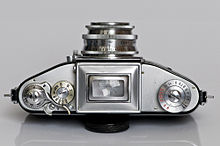Kine Exakta
The Kine Exakta is a 35mm camera . It was manufactured by the Ihagee company in Dresden. The Kine Exakta played the role of the first series-produced single-lens reflex camera . It is a milestone in the development of photography . It was produced in several variants between 1936 and 1949.
history
Single lens reflex cameras have been known since the late nineteenth century. After the advent of 35mm photography from 1925, however, it initially seemed impossible to make cameras for such a small format as SLR cameras due to the small viewfinder image. Karl Nüchterlein , designer at Ihagee in Dresden, initially designed a mirror reflex for the format 4 × 6½ cm on roll film A8 (marketed as Exakta or Standard-Exakta). From this camera he derived a 35mm camera, the underside of which was convexly curved, making it a powerful magnifying glass. This enlarged the viewfinder image so that it could be used to adjust the focus.
Technical
The camera has a trapezoidal cast housing with a screwed film track and a removable back panel.
The camera shutter is designed as a cloth slot shutter with two cloth cloths and can achieve exposure times of 1/1000 of a second up to a full 12 seconds. There is also a self-timer with times of up to six seconds.
On the top of the camera, to the left of the centrally located light shaft, is the time setting button for the short exposure times from 1/1000 second to 1/25 second plus B and Z (T), next to it the quick-action lever and below this the picture counter. A quick-action lever appears here for the first time on a 35mm camera. Between the time setting knob and the quick-release lever is the lever that cancels the film advance so that the film can be rewound into its housing. On the right side of the camera is the setting button for the long exposure times and for the self-timer function.
On the front of the camera you will find the shutter release button on the left of the lens in the direction of photography and the connection for flash lamps on the right. The lens mount is designed as a quick-change bayonet.
The tripod thread is centrally located on the underside of the camera, as well as the film key on both sides of the camera outer sides. This is used, for example, to rewind the exposed film. On the right side is the button that belongs to the film cutter, so that the film can be cut off prematurely and the already exposed part of the film can be used for development.
The viewfinder is designed as a light shaft that can be folded up for transport and then locks the shutter release. The top of the screen is designed as a magnifying glass. There is also a magnifying glass to enlarge the viewfinder image, which can be swiveled in if necessary. This is located on the front of the light shaft housing and, when swiveled in, provides a sports viewfinder . With the first cameras, this magnifying glass was round and only enlarged the center of the screen, but covered the rest. Later this was changed to a square magnifying glass. This was also easily possible afterwards, so today there are only a few original cameras.
The silver-plated mirror remained in its upper position after the exposure and was only swiveled back into its use position when the film was transported on.
The lens aperture was not triggered by the camera, as is common today, but had to be closed manually to the desired value.
Rating
The Kine Exakta played the role of the first series-produced single-lens reflex camera. As for its role as the very first single-lens reflex camera, the situation is unclear. The Russian "Sport" also claims this title. However, you can confidently see it as the archetype of all today's single-lens reflex cameras, as it combines all the features of modern cameras such as bayonet connection or quick-release lever.
literature
- Hummel, Richard: KINE EXAKTA or SPORT ?: Lindemanns Verlag 1997; ISBN 3-89506-160-3
- Cullen, Gary & Rademaker, Klaus: Exakta Obscurities, Strange and Rare: Delta, BC, Canada, 2001; ISBN 0-9689868-0-3 , ISBN 0-9689868-1-1
- Wurst, Werner: Exakta 35mm photography: Verlag Wilhelm Knapp, Halle (Saale) 1952
- Wichmann, Klaus: Exakta from the Kine Exakta to the Elbaflex: Lindemanns Verlag 1995; ISBN 3-89506-129-8
- Aguila Clement & Rouah Michel; Exakta Cameras 1933 - 1978: Hove Photo Books 1989 ISBN 0-906447-38-0
- Blumtritt, Herbert: History of the Dresden Photo Industry: Lindemanns Verlag 2001 ISBN 3-89506-212-X
- Kuc, Hans Jürgen: In the footsteps of the Contax Contax - history from 1932 - 1945: Wittig specialist book Hückelhoven ISBN 3-88984-118-X



